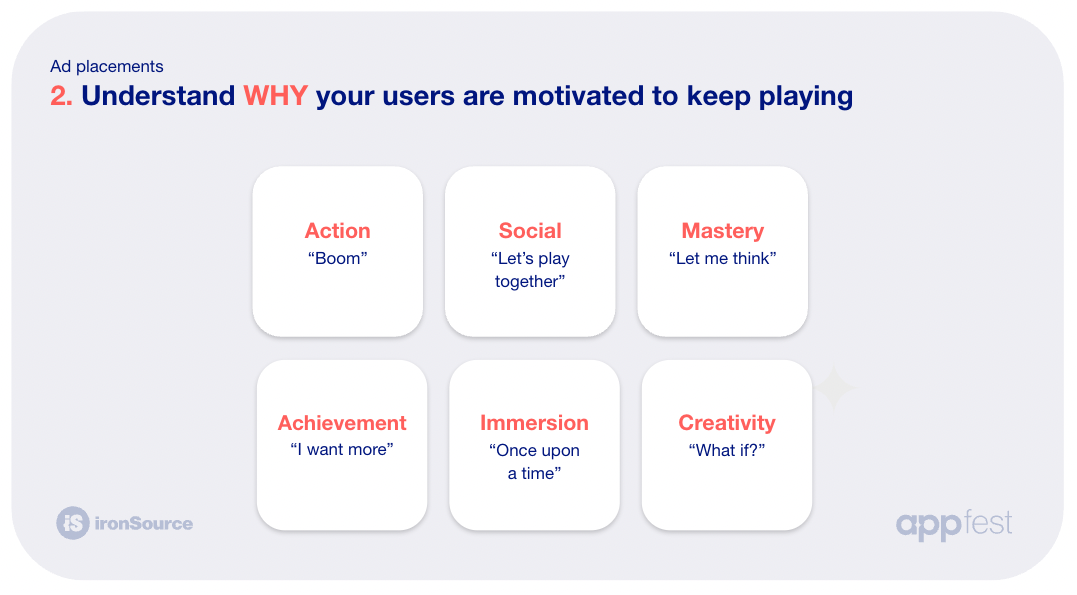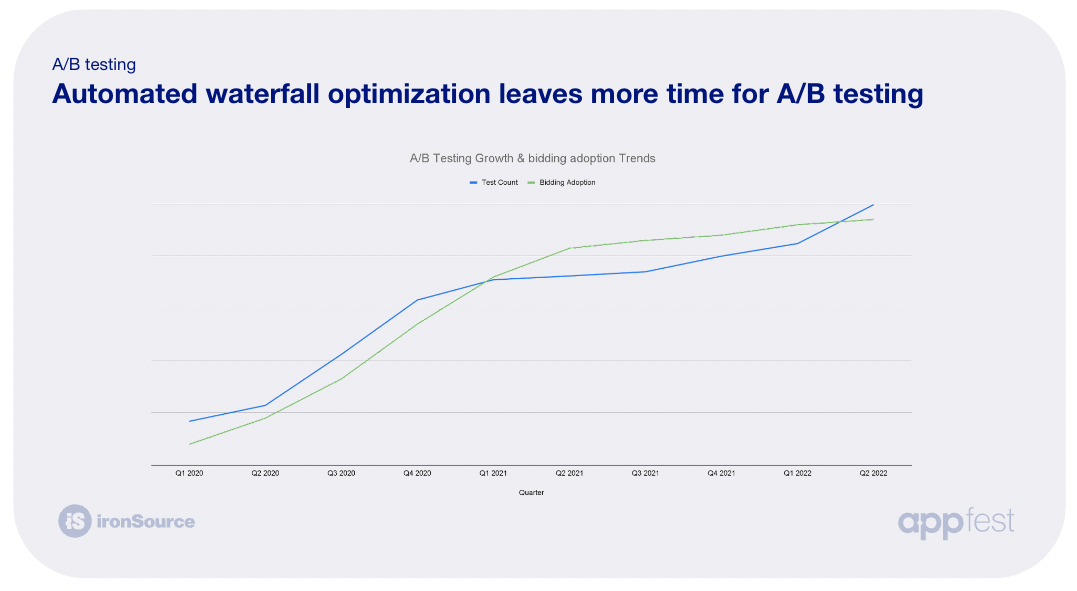At Appfest 2022, ironSource’s Maytal Shaul, Anna Popereko, and Yuval Lotan walked through 3 ways you can impact growth in the heavily automated App Economy - including tips for custom product pages, ad placement strategy, and A/B tests. Read the summary or watch the video below.
In the mobile app industry, automation has been a growing force - improving performance for both user acquisition and monetization. But as Maytal, VP Business Growth at ironSource explains, automation is not a threat to manual control. In fact, to get to the best performance, man and machine should work together.
Here are 3 areas where app and game companies can utilize this control and have the most impact.
Spend more time optimizing on ad strategy and placements
Yuval Lotan, ironSource’s Head of Platform Growth, kicked off the session with some important findings - optimizing placement strategy has significantly higher growth potential than optimizing waterfalls, up to 400% in fact. But surveying LevelPlay customers showed a disconnect in time allocation, with most studios investing the majority of their time into areas with the least growth potential.
So why do studios tend to invest less in placement strategy? There are three main reasons: risk, team structure, and data accessibility.

The retention risk
Naturally, changing your ad placement strategy can be riskier than changing your waterfall - since it can affect retention, playtime and in-app purchases while optimizing your waterfall won’t. But for those same reasons, it can also be much more beneficial. According to ironSource research, users who engage with rewarded video have much higher retention rates and are much more likely to make in-app purchases. That increase in performance makes it a risk worth taking.
Team structure
To best optimize your ad strategy, you need an expert, or a team of experts, who understand what your users need and how they respond to different ad units. But that can be difficult when your studio’s structure isn’t built for it.
It can be tricky, for example, to collaborate on placement strategy when the monetization manager, product manager, and game designer, all sit under different teams with different goals. One might prioritize in-app purchase revenue while the other prioritizes ad revenue.
That leaves you with three options:
- Make changes to your company structure, if needed
- Hire a dedicated person for this role, like we did at ironSource (more tips by her later)
- Outsource to an agency, like ironSource’s game design consultancy
Data transparency
Many studios also hesitate to invest in their placement strategy because it’s difficult to get transparency into what success looks like. Here are some of Yuval’s tips:
First you need to know what KPIs to look out for. Start with engagement rate, or the percentage of users watching your ads - which is the best way to evaluate your growth potential because it’s proportional to your revenue. Additionally, pay attention to impressions per engaged user and impressions per DAU.
Next, find out your category’s benchmark from your mediation partner - if you have a clear target, it’s much easier to define goals. For example, one RPG game compared their KPIs to the benchmarks and saw their rewarded video engagement rate was low but impressions/engaged user was high. From this, they understood that their ads were delivering good value to their users, but the traffic driver wasn't accessible enough for them to find it. In fact, when Yuval’s team built recommendations for this game, they calculated the game had a growth potential of more than 40%, because they estimated they could reach the genre’s median engagement rate. Eventually, this game boosted engagement rate by 60% - all while keeping retention stable.

Following Yuval’s call to spend more time optimizing placements, Anna Poperko, ironSource’s in-house Game Design Consultant, shared four tips on how to do just that.
Data is king
To fully understand how users are engaging with a traffic driver, Anna recommends comparing KPIs (engagement rate, impressions/DEU, etc.) rather than viewing them in isolation - this way, you get greater context for players’ behavior. Let’s say one placement has a very low engagement rate but very high impressions per/engaged user - you can conclude that players don’t notice this placement often, but those who do find it very valuable.

Understanding your players’ motivations
To monetize players, it’s essential to first understand them and what they need. Gamers are commonly split into standard motivational groups - mastery, achievement, creativity, and more. If, for example, you know your players are motivated by achievement, you can match their motivations to a placement strategy that suits their needs - like offering a rewarded video to help when they fail.

Know your competitors
To maximize your ad placement strategy, it’s always worthwhile to learn from similar games to know exactly what makes your competition succeed. Playing those games is an opportunity to compare and understand their user flow. Do they have more or fewer placements? Where are their placements located? Does their app address the same user motivations as yours? See what gaps you can fill in your placement strategy - every insight is an opportunity, and there’s always room for improvement.
Get inspired by other genres
Beyond competitors, Anna recommended getting inspired by other successful genres that lean on similar player motivations. For example, Anna worked with a first-person shooter game that never updated the items in their store - losing engagement from players. Inspired by racing games that have stores which refresh monthly, the shooter game decided to refresh their store items more often - and revenue quickly increased. Even though the genres were vastly different, they both had “achieving” player motivations in common.
Utilizing custom product pages
In addition to optimizing placements, Maytal covered another area for growth: Apple’s custom product pages, a product of iOS 15 which has huge potential to boost IPM and conversion rate. 15%-43% increase in IPM, 8%-37% increase in CVR, and 7%-40% increase in eCPM, to be exact. It works by connecting custom versions of an app’s App Store landing page to specific creatives.
Looking at the ironSource network, more than 40% of the spend is running with Apple’s custom product pages - and 90% of the advertisers utilizing custom product pages are running their UA through ironSource ROAS. optimizer. From that, we understand that automating their bid strategy gives them more time to focus on their creatives and product page experience.

As Maytal explained, there’s a reason why and how custom product pages boost IPM and conversion rate. Basically, they add an extra layer of optimization to the user journey - either towards your audience or your creatives. By optimizing custom product pages toward your audience, you get an additional opportunity to focus on language and localization, unique holidays, etc. Meanwhile, by optimizing towards creative elements, by adding screenshots, previews, similar colors, character, and other elements to match popular creatives, you get to build a better bridge between the product page and the creative that sent them there..
In fact, when Pocket Gems saw one creative outperforming the rest, they created a custom product page to include that creative’s theme and ran it on the ironSource network. After a successful A/B test, they implemented the new page into their main campaign, and their IPM boosted by 16% as a result. Learn how they did it with ironSource.

Applying A/B testing
A/B testing is another key strategy to optimize both user acquisition and monetization.
In fact, there’s a direct correlation between studios automating monetization by adopting in-app bidding and running A/B tests.

By A/B testing monetization, you can measure the impact of any in-game change without hurting KPIs. It also helps predict ARPU and retention uplifts, while giving a clear window into users’ behavior.
If you suspect that a change, even a small one - can boost your revenue or scale, it’s always worth finding out. In fact, among LevelPlay customers who A/B test - in 62% of cases, the B group wins - those who applied the new change saw their LTV grow by 7%. These changes might include adding/updating bidding networks, testing different ad placements (capping, pacing, rewards), and banner refreshment rate - all of which have the biggest impact on LTV.
To run A/B tests successfully, Maytal recommends:
- Challenging existing strategies you have - user behavior in a game is always changing
- Testing a wide cohort of users to see the A/B tests impact on all audiences
- Looking at both overall and granular results to better understand that the change will impact all groups positively
- Testing everything - everything has potential to be optimized
Simultaneously, Maytal suggests:
- Avoiding running tests that are too long in order to not risk hurting KPIs
- In order to always pinpoint what is affecting results, don’t run test different test versions simultaneously
Ultimately, while the automation tools we have have great potential to increase performance, there is always room for manual optimization - we just have to find the best places to do it.

